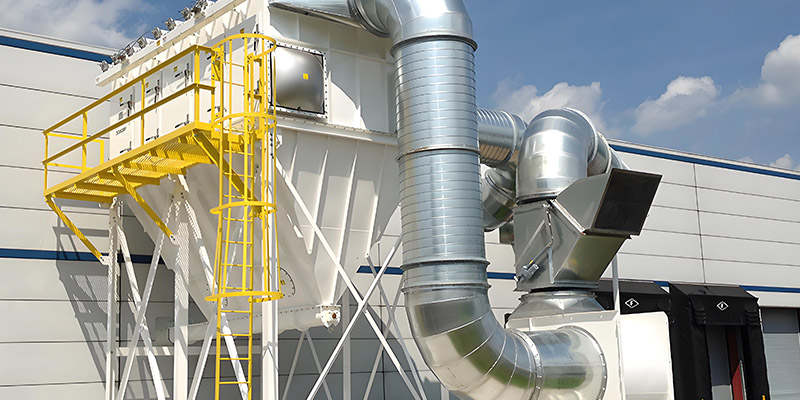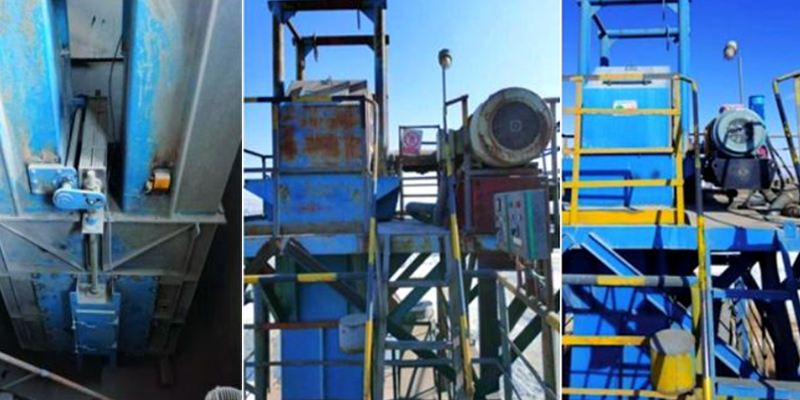Baghouse dust collectors are efficient dry filtration systems. They remove dust from gas streams using filter bags. Their dust removal efficiency is much higher than cyclone dust collectors and water screen dust collectors. They also perform better than electrostatic precipitators. This technology is now mature, user-friendly, and widely used for efficient dust removal. These systems offer large capacity, stable operation, simple use, high purification efficiency, and minimal maintenance.
The main structure includes an upper casing, a middle casing, a lower casing (dust hopper), a cleaning system, and a dust discharge mechanism.
To control airborne pollutants in workshops, we use local ventilation methods. Simply put, we install capture hoods at pollution sources. These hoods collect polluted air and send it through the baghouse dust collector. After purification, the clean air releases outside. This method is the most effective and common for pollution control in production workshops.
Main Selection Criteria
We select baghouse dust collectors based on four main factors:
1. Air Volume
Air volume means the total airflow entering the baghouse. It includes:
-
Air captured from the dust source equipment.
-
Necessary reserve air volume.
-
Air leakage from valves and ducts.
-
Air added for direct cooling.
Processing air volume is a key factor in design and selection. The size and specification of the baghouse depend directly on this air volume.
2. Operating Temperature
The operating temperature is the inlet temperature of the dusty gas. Often, we must adjust this temperature (cooling or heating). This ensures we select suitable and economical filter media.
3. Gas Characteristics
We must identify if the gas has special properties. These include being flammable, explosive, or corrosive.
4. Emission Requirements
The outlet dust concentration must meet standards. These standards are set by national, industrial, and local regulations. This is a basic principle for selecting and designing baghouse dust collectors.
Components of the System
A complete baghouse dust collection system has several parts:
(1) Capture Hoods: These hoods capture polluted air. Their design directly affects the system’s performance and cost.
(2) Ducts: These pipes transport the airflow. They connect all system components together.
(3) Purification Equipment: This is the baghouse dust collector itself. It treats the air when pollutant levels exceed standards, preventing air pollution.
(4) Fan: The fan provides airflow power for the whole system. We usually place the fan after the purification equipment to prevent wear and corrosion.
(5) Stack: The stack releases the purified air from the system.
The purification equipment is the most critical part. Choosing the right equipment determines the system’s overall dust removal effectiveness.
How to Determine the Model
First, we decide what type of capture hood to use. A good hood uses minimal air volume, avoids affecting work, is simple to operate, and has low cost. A smaller hood air volume means lower investment and operating costs. We place the hood close to the pollution source or dust point. We also prefer enclosed hood designs.
The dust collector’s air volume equals the total air volume needed to capture dust from all sources. We design capture hoods and ducts to draw the dusty air into the collector.
After determining the air volume for each hood, we add them together. This sum gives the total processing air volume for the dust collector. Then, we calculate the pressure drop to select the correct fan model.
We calculate the dust collector’s air volume using this formula: Air Volume = Filter Area × Air-to-Cloth Ratio.
-
Filter Area = Single Bag Area × Total Number of Bags.
-
Single Bag Area = Diameter × π × Height.
-
For example, a 133×2000mm bag area is: 0.133 × 3.14 × 2 = 0.835 m². A 2.5m bag is about 1.044 m².
-
The Air-to-Cloth Ratio is typically between 0.6-2.0 m/min, or more commonly 0.8-1.5 m/min. We choose this based on emission standards and other factors.
For example, a DMC-100 unit with 133×2000mm bags handles an air volume between 5011-7517 m³/h at a 0.8-1.5 m/min ratio. A lower air-to-cloth ratio means slower air speed through the bags. This improves dust capture and results in lower emission concentrations.

Filter Bag Materials and Construction
Inside each filter bag, a cage provides support. This cage prevents the bag from collapsing. It also helps remove and redistribute the dust cake during cleaning.
The filter bag material and design aim for high efficiency, easy dust release, and long life. Choosing the right bag is essential for good performance. We select bags based on:
-
Gas temperature
-
Humidity and chemical nature
-
Dust particle size
-
Dust concentration
-
Air-to-cloth ratio
-
Cleaning method
Types by Temperature:
-
Standard Temperature Bags: These are made from materials like polyester, polypropylene, or acrylic. They are made using non-woven or weaving processes. They offer good permeability, a smooth surface, stability, and easy dust release. Factories use them for general dust removal and ambient air treatment.
-
Medium Temperature Bags: New synthetic fibers allow bags to handle harsher conditions and last longer. Common materials include aramid and PPS fibers. These bags undergo special treatments for water, oil, and corrosion resistance.
-
High Temperature Bags: Common materials are P84, expanded PTFE, and fiberglass. They are made by weaving or non-woven methods. These bags offer great thermal stability, high filtration efficiency, and long service life. We use them for high-temperature gas streams. For very harsh conditions, we use DWD material bags. For ordinary dust, polyester bags often work.
Manufacturing Requirements:
Bag sewing quality is crucial for longevity. Manufacturing must follow the GB12625-2007 standard. The sewing thread, often PTFE, should be superior to the bag material itself.
-
The vertical seams must be strong, straight, and have at least 3 lines of stitching.
-
The stitch spacing must be 24-30 stitches per 10 cm.
-
The seam width should be 10-15 mm.
Preventing Damage:
Damage often happens at the bag top and bottom.
Bag Top (Collar):
-
Wear occurs here because clean air concentrates and exits at this point.
-
Frequent pulse-jet cleaning also causes abrasion.
-
We use double-layer material at the top and control cleaning frequency.
-
The collar is made from 1Gr17Ni7 stainless steel strip.
-
The seal uses material matching the filter media, with the upper layer being thicker for a tight fit to the tube sheet.
Bag Bottom:
-
Damage comes from dust abrasion and friction.
-
We use double-layer material at the bottom.
-
The outer reinforcement layer is 120 mm high.




